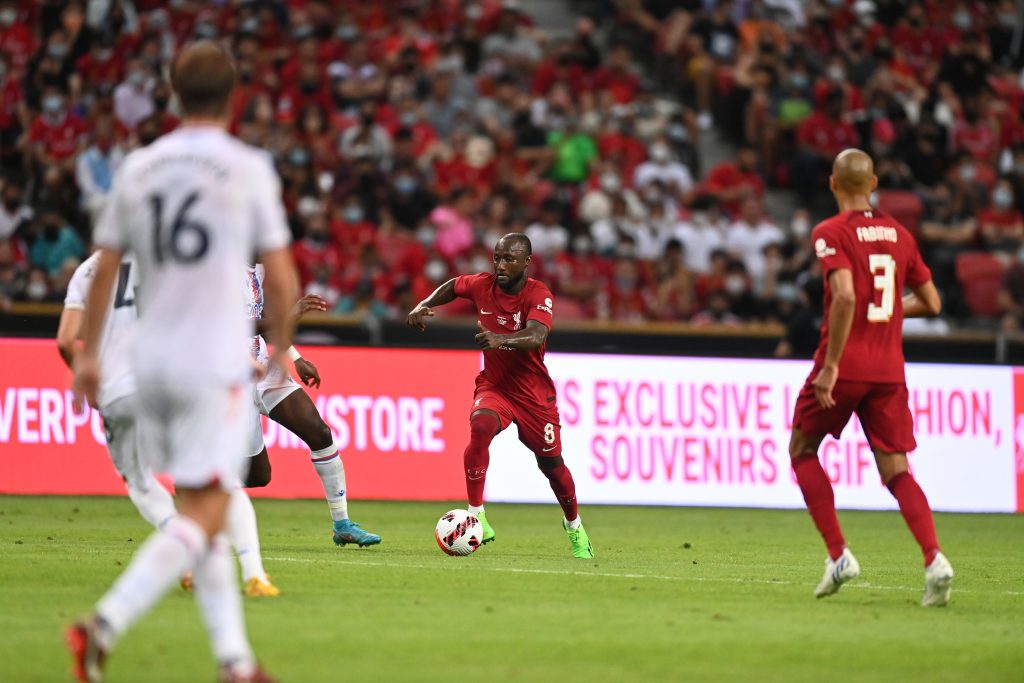Sam McGuire takes a deep dive into Naby Keita’s skillset and asks if he is to be replaced at Liverpool, what is the most effective way of doing it
Naby Keita was supposed to be a transformative signing for Liverpool when he joined the Reds in 2018 following an extra year in Germany with RB Leipzig. It is somewhat ironic that in the 12 months between him agreeing to move and him actually making the move, the Reds transformed their midfield without him.
The first true version of Jurgen Klopp’s Liverpool team arrived during the 2016/17 campaign. It was heavy metal football, chaotic and frenetic. Fans really got to see what the German tactician meant when, on Monday Night Football, he said: “No playmaker in the world can be as good as a good counter-pressing situation.”
Gini Wijnaldum was surprisingly deployed as a box-to-box midfielder following his move from Newcastle United. In his first season at Anfield, he scored six times and assisted nine while Adam Lallana, used on the other side of Jordan Henderson, scored eight and chipped in with seven assists. Even Emre Can found himself amongst the goals, scoring a career-high five in the league.
That was the midfield Liverpool wanted to improve upon. They needed an all-action middle-third dynamo who could impact every phase.
Keita looked like the ideal player for this. He had 15 goal involvements in his debut season in Germany. The ex-Salzburg man was a destroyer, a progressor, and someone who could retain the ball, all at the same time. A great example of this is below.
In a NY Times feature published in May 2019, writer Bruce Schoenfeld spent time with Liverpool’s data team and Keita was given a lot of coverage as a result of him being an Ian Graham pick. There is a snippet in there that really paints a picture of the Guinea international.
“What scouts saw when they watched Keita was a versatile midfielder. What Graham saw on his laptop was a phenomenon.”
Yet now, five years into his Liverpool career, the phenomenon seen in two Red Bull-owned midfields has not established himself in the red of Liverpool. There have been flashes of that highlight reel player, but those sightings have been at a premium.
It is easy to understand why this is the case.
The 2017/18 campaign, the one Keita spent in Germany despite RB Leipzig and Liverpool striking a deal, was a sliding doors moment for Klopp. Teams started to sacrifice possession in favour of controlling the space against the Reds. There weren’t as many transitional moments and this nullified the counter-press playmaker. Liverpool ended up with a lot of sterile possession.
Carlos Carvalhal, then the manager of Swansea City, said as much in a post-match interview following a 1-0 win in January 2019:
“I said to my players that Liverpool were a top team, they are really strong, but they are a Formula 1 car. If you put a Formula 1 car in London in traffic, the Formula 1 car will not run very fast.”
As a result, Klopp tweaked the style.
Play was funnelled into the wide areas to the likes of Andrew Robertson and Trent Alexander-Arnold, while the outside centre-midfielders acted as facilitators. They would cover wide areas, as opposed to getting into the penalty area, and took fewer risks in possession. This had an impact on output: Wijnaldum, for example, scored just once in the league during that season.
Keita joined when the midfield unit was tasked with being a cog in a system. He had to curb his natural instincts and play the game the team needed him to play. Instead of taking players on during marauding runs, he regularly opts to slide a pass into the forwards.
The result was fewer dribbles, more passes, and a higher pass accuracy. He became risk-averse and instead opted for functional. Keita is a chameleon, but fans wanted a peacock. The Liverpool No8 excelled in every department other than goals and assists. Sadly for him, the expectation was that he would bring that to the midfield. The fact he has failed to do so has skewed how he is viewed by some fans.
Injuries have not helped his cause either and he has not been able to carve out a place in Klopp’s best XI. Assistant manager Pep Lijnders recently released a book and there is a telling section on Keita.
“It has to be said, Naby is the best substitute player you can imagine in these kinds of games. Everyone in the opposition is tired and he can dribble past them as if they are mannequins.”
Somehow, it is both a compliment and a bit of a dig at the same time. No player in their prime should be content with the best substitute tag. However, this has been a running theme for the best part of five years now and it appears as though it might be coming to a head.
According to reports in Germany, the player is unhappy with how things are going on Merseyside and a move could well be on the agenda, with talks over a new contract coming to a standstill. His deal expires at the end of the current campaign and the Reds will have to weigh up whether they can really afford to let their fourth most expensive signing leave for nothing.
Does he deserve a more prominent role in the Liverpool team? And if he does leave, who can feasibly replace him?
With the help of Transferlab, we can take a look at the player and some possible solutions if he does depart.
The Keita Profile
One of the best things about TransferLab is the ability it gives users to compare players across different profiles. We compared Keita here with all central midfielders in Tier 1, which is Europe’s top five leagues.
Firstly, this is how Keita ranks within the ‘box-to-box’ midfield profile. The 27-year-old is in the 90% percentile for a lot of key midfield metrics. His long passing game has never been a strength – he’s much better with his short game – so it is little surprise to see that he ranks in the 19% percentile for that particular metric.

What is impressive is that he’s posting these numbers across multiple roles. As shown in the heat map, he has played on both sides for Liverpool over the last 12 months. This is particularly interesting because the left-sided central midfield role for the Reds is that of a controller while the right-sided midfielder is given much more attacking freedom.
The box-to-box profile is largely tied to on-ball events. The ball-winner profile within the TransferLab looks at different metrics, as you can see below.

Again, though, Keita ranks favourably across a number of them.
He is, and always has been, a statistical phenomenon. Finding someone who can practically do everything to a high level is not going to be as easy as people think. There might be a trade-off whereby they are better on the ball than they are off of it, or vice versa, but genuinely all-round midfielders are rare. Especially those playing at the level Keita is.
Finding an alternative
So, how would we go about finding such an unusual type of player. TransferLab’s ‘similar players’ function allows us to do exactly that. And although we’ve seen how Keita is outstanding across several profiles, given that Liverpool now look to dominate the ball, our focus will primarily be on the box-to-box profile.
In addition, because Liverpool tend to succession-plan, our search will look at players aged 23 or under with at least 1,300 minutes played in the league across the last 12 months.

The numbers in yellow are similarity scores ranging from 100 (completely the same) to 0 (completely unalike).
You’ll note some very interesting names. In fact, Gavi and Jude Bellingham have been linked with Liverpool heavily over recent months, so that is quite telling.
There are a few players you can rule out, such as Ryan Gravenberch and Mateo Guendouzi, as they have only recently signed for new clubs. It is also unlikely that Chelsea will sell Conor Gallagher to a rival, so he can be crossed off the list.
Instead, we’re going to have a more detailed look at a few of the closest matches. We have selected Gavi and Bellingham, as well as Hoffenheim’s Christophe Baumgartner and Aston Villa’s Jacob Ramsey, the Premier League option.

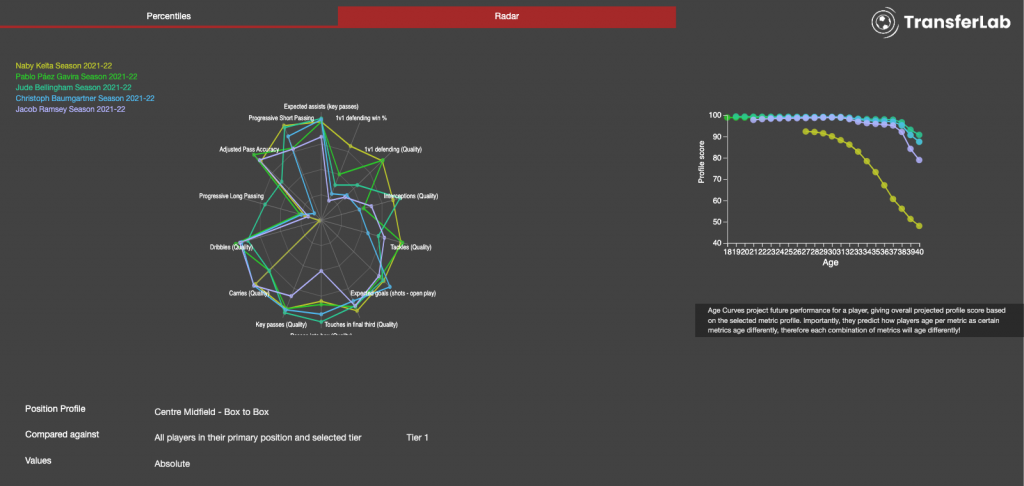
Gavi
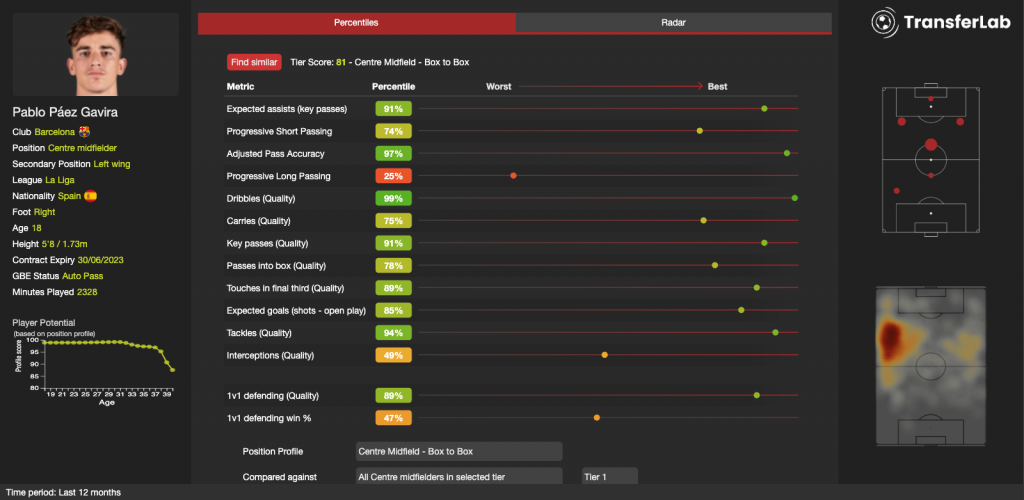
The Barcelona maestro is set to sign a new long-term deal with the Spanish giants but at the time of writing, nothing has been confirmed. The 18-year-old had a 2021/22 campaign to remember and even forced his way into the international picture.
He is everything you expect a Barca midfielder to be. He is progressive in possession, forever probing and perpetually on the move looking for space to exploit.
Gavi has that scramble-style of dribbling that allows him to slalom past opponents at the very last minute. This differs to Keita who adopts more of an upright stance and takes heavier touches.
The youngster played primarily on the left for Barcelona but did make a few appearances on the right. He does share a lot of similarities with Thiago and this might work in his favour.
Liverpool have a number of dual midfielders in the sense they can operate on both sides. However, ‘doing a job’ and excelling in a role are two different things entirely. James Milner is functional on the left, but he can’t do what Thiago does.
Similarly, Curtis Jones has played on the left, but he plays the role differently to the Spanish maestro, as does Keita. Rather than necessarily being a weakness, though, it just means that when the former Bayern midfielder isn’t available, the Reds have to tweak their approach. But having a player like Gavi would allow Klopp to play in an almost identical manner. He wouldn’t just be a replacement for Keita, he could be Thiago’s heir.
For sustained success, you want long-term successors in place.
Jude Bellingham

If there is one thing that goes against Gavi, it is his height. It isn’t the be-all and end-all in the modern game but Klopp has previously mentioned his reluctance to use Takumi Minamino in certain games due to his height. This won’t put Liverpool off but it is something to consider, as they don’t want to find themselves in a situation where their three starting midfielders, due to injuries, are all under 5’8″.
Reports over the summer claimed the Reds wanted athletic and physical midfielders for their 2023 revamp. And Jude Bellingham ticks both of those boxes, as well as being an exceptional linking midfielder.
He may still be a teen but he has a lot of experience at the very top level. He has made over 90 appearances for Borussia Dortmund and he is already into double figures for England caps.
Though Bellingham has spent the majority of his time in a double pivot for BVB in the Bundesliga, he could end up being the long-term successor to Jordan Henderson on the Liverpool right.
The 19-year-old has the height, the running power, the engine, and the technical ability to link up with Trent Alexander-Arnold and Mohamed Salah on that side of the pitch.
It highlights how versatile Keita is that the top two picks on this list are players who could well succeed Thiago and Henderson in the Liverpool starting XI: different roles and varying styles, yet the Liverpool No. 8 manages to do both seamlessly.
Christophe Baumgartner
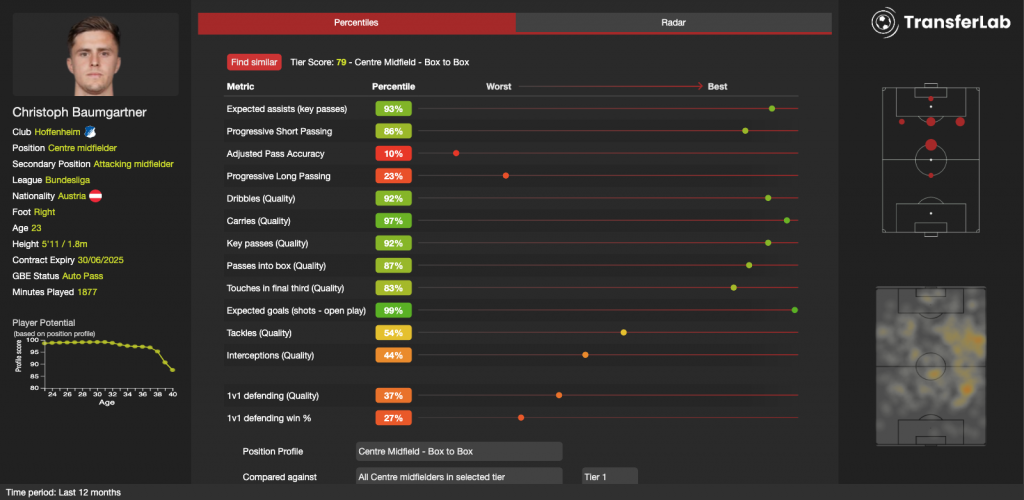
Liverpool have a proven track record of identifying undervalued talent and helping them develop. A 23-year-old Austrian playing for Hoffenheim might not be the midfield signing fans are hoping for but he could well be what the team needs if Keita does depart.
Baumgartner is everything that you want from a progressive midfielder. He is in the 80% or 90% percentile for practically everything and given he started life as an attacking midfielder and he has played as a winger, he is comfortable in wide areas. He offers the greatest goal threat of our picks, too, based on expected goals. Deployed almost exclusively on the right, he does like to drift all over the pitch. The only slight concern is his adjusted pass accuracy but a factor in this might be that he’s tasked with being the creative outlet for Hoffenheim. He makes high-risk, high-reward passes that don’t always come off. That can be worked on though; Liverpool have done the same with multiple midfielders.
Baumgartner would replace the right-sided midfielder version of Keita. The 23-year-old has the height, the ball-carrying ability, and he is a goal threat. The Hoffenheim man is fleet-footed, nimble and very tidy on the ball.
Jacob Ramsey
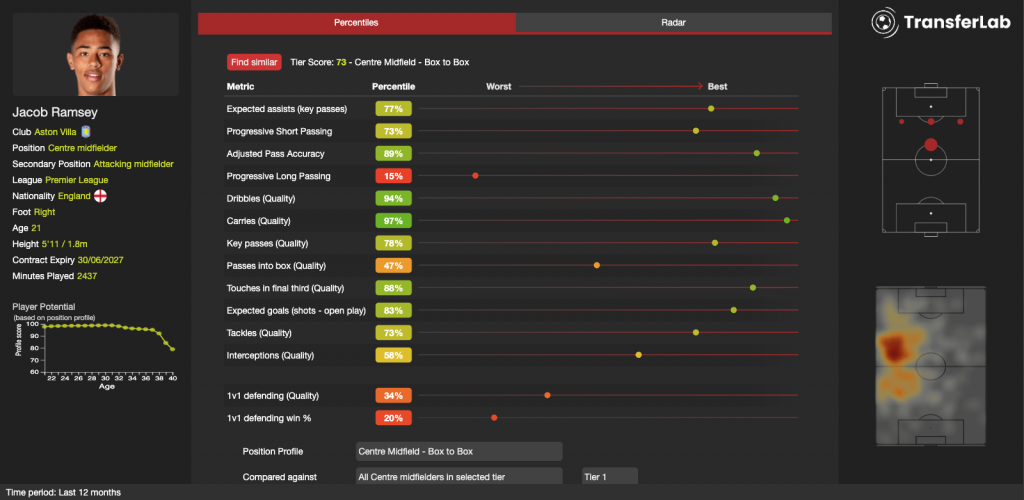
The 21-year-old has a breakout 2021/22 campaign and his form resulted in a new, long-term deal at Villa Park. You could call Ramsey the Premier League version of Bellingham.
He’s got height and stamina, quick feet, and he’s calm under pressure. Ramsey can sit in the middle of the pitch, receive under pressure and move the ball on. His short game is crisp and precise. His long game needs work before he can truly be a controller in midfield: he’s in the 15th percentile for progressive long passes ranked against other Tier 1 central midfielders, the lowest on the list. But, there is no doubt that the potential is there.
Like Bellingham though, he would be better suited to the right-side of the Liverpool midfield in the current system. Afforded the freedom to pop up in central areas and act as a fourth attacker, his runs off the ball could marry well with the players Liverpool already have at their disposal.
Conclusion
Keita is multiple players rolled into one.
Liverpool have benefitted from this but they are now at a stage, due to Klopp’s tactical evolution, where they need more specialists due to already having a number of versatile players within the squad. Liverpool need to fill roles, not positions.
Their system is reliant on having three distinct profiles in the middle third to be at its very best and they don’t possess back-ups that allow them to play the same way when certain individuals are missing. An overhaul is coming, regardless of whether or not Keita is sold. Alex Oxlade-Chamberlain is out of contract next summer and James Milner can’t play on forever. Henderson is 33 this season, while Thiago is 32 in April and Fabinho is 29 in October.
The clearest lesson from our work with TransferLab is that while it is possible to find players whose overall skillset aligns with Keita’s, because that skillset is so broad, these players would work best when fitted into one of the three distinct roles in the Liverpool midfield. Liverpool should, for the purposes of squad-planning at least, assign a set role to Keita and then think about replacing him for that role, rather than trying to find a player who does everything.
Image credit: Shutterstock/Daykung

